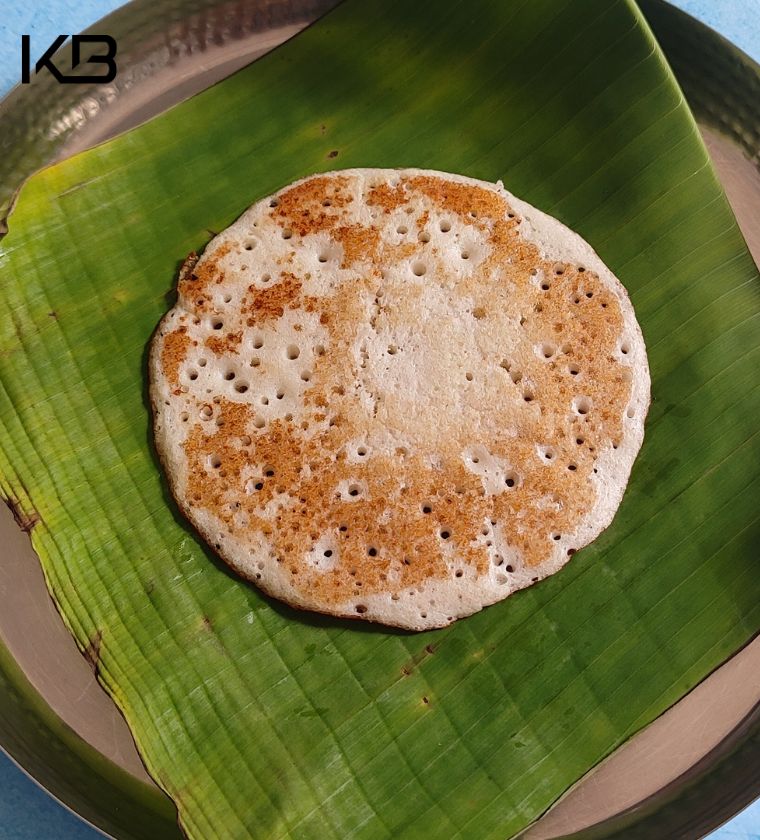What is Amboli –
Amboli combines the words “poli” and “Ambavne.” Poli is Pancake, and Ambhavne is the fermentation process. It is also called as Polye.
It is a thick fermented Pancake cooked in a “Bidacha Tawa,” a hot cast iron skillet. It has a very soft, fluffy top and a somewhat crisp bottom. Amboli is naturally gluten-free as it is made with fermented batter of Rice & other grains and pulses.
It typically cooks on one side, which softens and fluffs the top side, but occasionally it cooks on both sides. This time, I’ll talk about the second version. The top side is white when cooked on one side, but it turns somewhat reddish when cooked on both sides. It’s a delightful sight to see.
What is the Amboli made up of? / What is Amboli Pith?
Amboli is made with Amboli Pith. It is a fermented batter preparation, that takes two days. On the first day, rice, black gram split, fenugreek seeds, and chickpea split must be soaked for seven to eight hours. Then, the mixture of grains, pulses, and seeds must be ground into a fine paste and allowed to ferment overnight.
Are Amboli & Ghavan are same?
They have a few things in common.
- They are an essential component of Malvani cuisine.
- They are excellent illustrations of Malvani cuisine’s minimalist approach. Use simple and readily accessible ingredients and a straightforward procedure, yet they are incredibly rich in flavor and texture.
- In general, they cook in the same manner using a Bidacha Tawa, which is a cast iron skillet or pan. The top side is steam-cooked by covering the pan with a lid, while the bottom is cooked on the pan.
Otherwise, they used a different procedure and other ingredients.
- To make Ghavan, rice is soaked overnight and ground the next day to create a fine, watery batter. In contrast, Amboli Pith is made by fermenting a thick batter of rice, black gram split, fenugreek seeds, and chickpea split, which is first soaked and then fermented for a whole night.
Here are some suggestions that may be of relevance to you:-
- Malvani Chicken Rasso: Sizzling kick on Sundays
- Malvani Mutton Chaap Masala
- Malvani Sukha Chicken – Spicy juices crawling on your tounge
- Kalya Vatanyacha Sambara – The Ultimate Malvani Veg Curry
What is the difference between Amboli & Dosa?
Amboli is a Malvani dish, while dosa is a South Indian dish. Although they use different ingredients and amounts, both are produced with fermented batter. Amboli is a fluffy pancake, and dosa is a crispy crepe.
Which South Indian dish is similar to Amboli?
Amboli resembles South Indian foods such as Uthappam and Sponge Dosa. Uthappam is topped with diverse vegetables, however, Amboli is not.
How is Amboli served?
It is a favorite breakfast meal for the Malvani people, although it can also be eaten for lunch or dinner. Coconut Chutney, Malvani Sambara, Sheglachi Bhaji, Malvani Chicken, and Malvani Mutton are served alongside Amboli during lunch or dinner. However, I enjoy eating with morning tea. I adore the soft, fluffy texture on top and the somewhat crispy bottom. The vapors cause the top part to become soft and fluffy when we cover it with a lid. We will lose that fluff if we flip it. However, it adds a lovely shade of red.
Amboli is prepared in every Malvani home for a variety of events, including –
- Gokul Ashtami, we prepare Amboli with Sheglachi Bhaji (Moringa Leaves Bhaji) as a offering to Lord Krishna.
- Amboli beside Coconut Chutney and Hot Steamy Chay On Sundays Breakfast
- On special occasions when Family or friends visit for Lunch or dinner we serve Amboli with Sambar (Veg) or Chicken or Mutton (Non-Veg)
Does Amboli have multiple versions?
Khaproli is one of Amboli’s variants. Khaproli is simply the addition of a few more pulses.

Discover the Secrets to Soft & Fluffy Malvani Amboli!
Description
It is a thick fermented Pancake cooked in a "Bidacha Tawa," a hot cast iron skillet. It has a very soft, fluffy top and a somewhat crisp bottom. Amboli is naturally gluten-free as it is made with fermented batter of Rice & other grains and pulses.
Malvani Aamboli
Main Ingredient
Cooking Ingredients
Instructions
Washing & Fermentation (Day 1 - Morning)
-
Take 3 Cups of Rice
We can use any type of rice, simple or fragrant. Here, I utilized rice grown locally in Kokan. -
Rinse the rice thoroughly in running water, at least 3-4 times.
-
Similarly, thoroughly rinse the 1 Cup Black Gram Split, 1 TBSP Fenugreek seeds, and 3 TBSP Chikpea Split under running water at least 3-4 times.
-
Mix the washed rice, black gram split, fenugreek seeds, and chickpea split.
-
Let the mixture soak for a minimum of seven to eight hours.
Day 1 (Night)
-
Grind the soaking material into a fine paste with a lot less water.
-
To measure the height difference after fermentation, dip the spoon into the ground batter prior to fermentation.
Better to add ground leftover Rice to the batter -
Add 1 TBSP Oil to the Batter.
-
Cover with a lid and allow it to ferment overnight.
Day 2 - Morning
-
Next day, dip the spoon again into the batter to verify the height of the batter after fermentation.
-
Take the desired batter and season with salt to taste.
Save the leftover batter in the fridge for another time. You can use it for next 2-3 Days. -
Add the appropriate amount of water to reach the pouring consistency.
-
Mix it thoroughly.
-
Grease the cast iron pan with oil after heating it over medium heat.
-
Pour the batter into a heated skillet and cover with a lid for two minutes. After that, turn it over to cook on the other side.
-
Soft and fluffy Amboli is ready for serving.


















